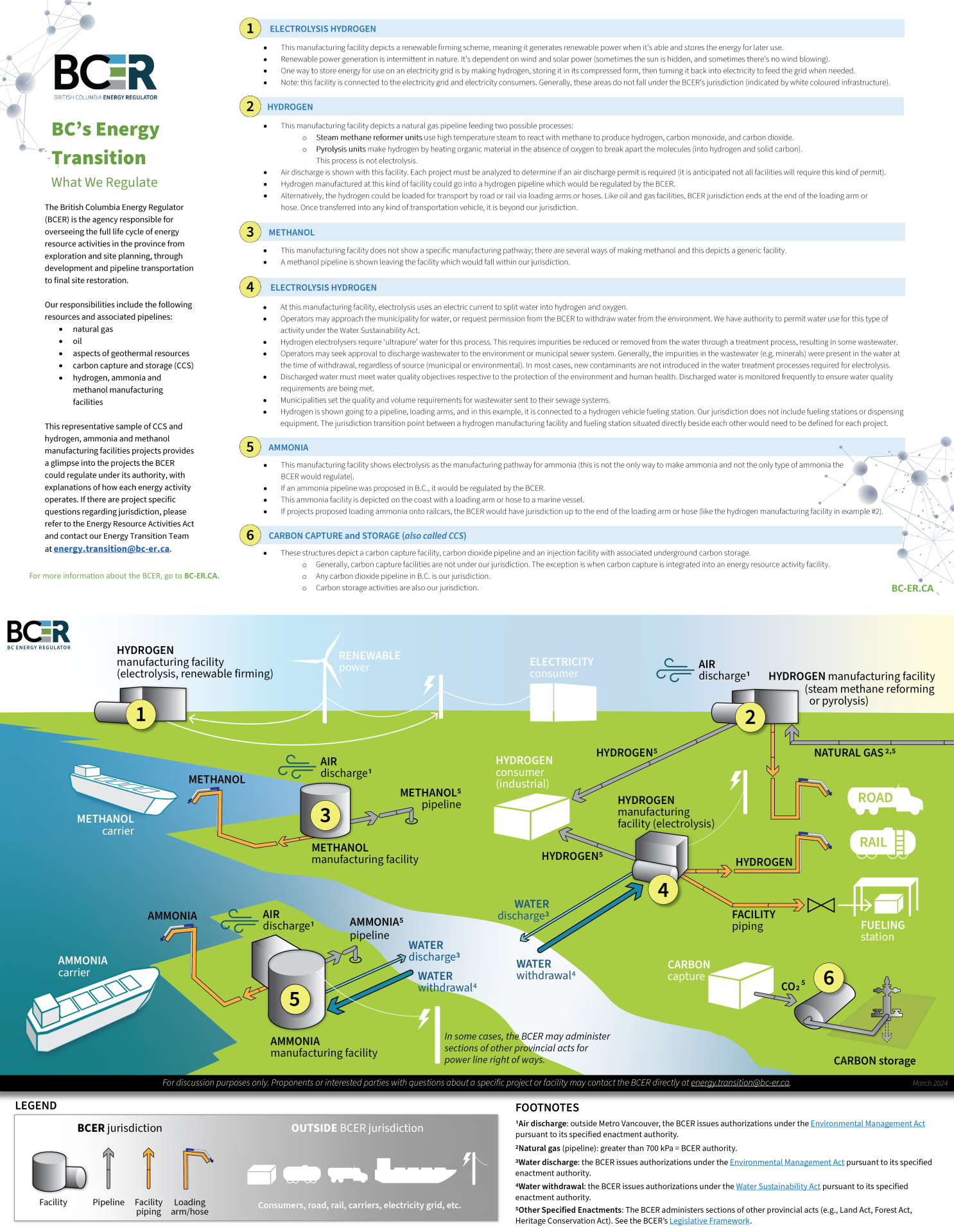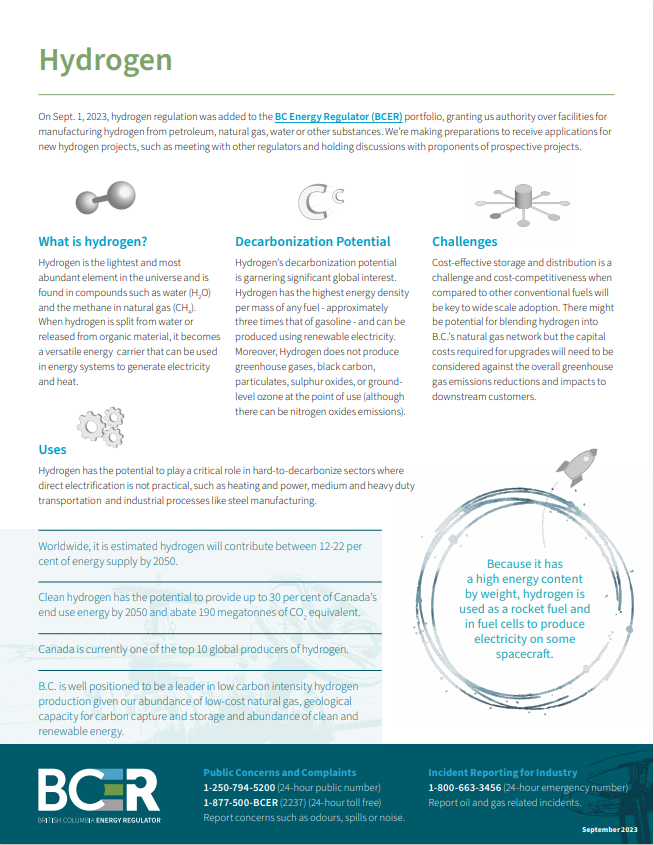Hydrogen is the lightest and most abundant element in the universe and is found in compounds such as water (H2O) and natural gas (CH4). When isolated, it becomes a versatile energy carrier that can be used in energy systems to generate electricity and heat.
In November 2022, the Province of British Columbia passed a bill that added hydrogen to the portfolio of energy resources under the purview of the BC Energy Regulator (BCER), including granting the BCER regulatory authority over facilities for manufacturing hydrogen from petroleum, natural gas, water or other substances.
Demand for energy in B.C. is highest in the industrial sector, followed by transportation, residential and commercial use. Hydrogen can be applied to each of these sectors in B.C. and could replace a significant percentage of demand currently met by fossil fuels.
- from the B.C. Hydrogen Strategy
On Sept. 1, 2023, hydrogen, ammonia, methanol and expanded powers on carbon storage reservoirs were added to our existing mandate on oil, gas and geothermal activities.
The graphic below provides a representative sample of projects we could oversee within the scope of these new authorities. It helps explain the manufacturing processes for hydrogen, ammonia and methanol, the associated pipelines, different methods of transport and the extent of where our jurisdiction begins and ends. [Clicking on the graphic will make it larger]

Check out our hydrogen factsheet below, or the B.C. Hydrogen Strategy for more information about hydrogen development in the province.

Application Manuals | Date Published:
Hydrogen Facility Application and Operations Manual (vDRAFT) (pdf)
The Hydrogen Facility Application and Operations Manual is a comprehensive how-to document for Class 1 and Class 2 hydrogen facility applications, related applications, and associated operations. This manual explains the Regulator’s Application Management System (AMS) for Class 1 and Class 2 hydrogen facility and related permits.
| Effective Date |
April 1, 2025 |
B.C. Hydrogen Strategy FAQ
What is hydrogen?
Hydrogen is the lightest and most abundant element in the universe and is found in compounds such as water (H2O) and natural gas (CH4). When hydrogen is split from water or released from organic material, it becomes a versatile energy carrier that can be used in energy systems to generate electricity and heat. When burned or used in a fuel cell, hydrogen produces no carbon emissions.
How is hydrogen produced?
Hydrogen can be produced from fossil fuels, biomass and clean electricity, and it is also a byproduct in some industrial processes. Several hydrogen production pathways are possible in BC.
Why do I hear people talking about the “colour” of hydrogen?
Hydrogen production pathways are often represented by colours based on the production process used:
GREEN hydrogen is produced from renewable sources, such as using clean electricity (e.g., hydro or wind power) to split water into hydrogen and oxygen through a process called electrolysis. Green (or renewable) hydrogen has a low carbon intensity when produced using clean electricity.
BLUE hydrogen is produced from non-renewable sources through steam methane reforming (SMR) with carbon capture and storage (CCS) or pyrolysis of fossil fuels, such as natural gas. With CCS, carbon dioxide is separated and sequestered underground, which reduces the carbon intensity of the produced hydrogen. With pyrolysis of natural gas, solid carbon is a by-product. Blue hydrogen (or hydrogen from fossil fuels with CCS) has a low carbon intensity when produced using fossil fuel feedstock coupled with adequate and permanent CCS.
GREY hydrogen is produced from fossil fuel sources, but without CCS. Grey hydrogen does not have a low carbon intensity.
Why is B.C. interested in Hydrogen?
British Columbia has the resources to produce both green and blue hydrogen with low carbon intensity. More than 98% of B.C.’s electricity is renewable, allowing us to leverage our clean electricity to produce green hydrogen via electrolysis. B.C. also has low-cost natural gas reserves, significant geological storage capacity and expertise in carbon capture and storage (CCS) technology, giving us the potential to produce blue hydrogen from natural gas with adequate and permanent CCS.
Hydrogen can be used in fuel cells to produce energy for transportation and stationary power systems, especially important for industrial sites and remote communities powered by diesel. When blended into the natural gas grid, hydrogen can displace fossil fuels to heat and power our homes and buildings. Hydrogen can also be used for producing low-carbon synthetic fuels to reduce emissions in transportation and industry.
Because of its versatility, hydrogen is one of the only solutions for decarbonizing sectors of the economy contributing to British Columbia’s CleanBC emissions reduction target. Given B.C.’s proximity to export markets, B.C. could also capture a significant portion of the global hydrogen market estimated to be greater than $305 billion by 2050.
How might hydrogen be used in B.C.?
Some end uses of hydrogen include lower-carbon natural gas, zero-emission transportation, low-carbon or synthetic fuels, power generation and storage, industrial processes and export.
What are B.C.’s Goals from the Hydrogen Strategy
British Columbia has a vision of becoming a world-leading hydrogen economy by 2050.
Their goals include:
- Promoting innovation and investment in the production and deployment of hydrogen to achieve the energy system transformation required to meet CleanBC greenhouse gas (GHG) reduction targets;
- Create economic development opportunities across B.C. through increased and equitable employment in trades, cleantech and energy services;
- Improve air quality and reduce contamination and noise pollution in urban and remote communities;
- Make clean energy solutions more diverse, convenient, available and affordable for British Columbians; and
- Fulfil our commitments under the Declaration on the Rights of Indigenous Peoples Act.
How do Methanol and Ammonia Relate to Hydrogen?
Hydrogen can be stored in either liquid or gas form for later use. Hydrogen can also be stored in liquid chemical carriers, such as methanol and ammonia, or by bonding hydrogen to toluene, where high densities of hydrogen can be stored at lower pressures. This is seen as a potential method to achieve high volume hydrogen exports.